1997 OLDSMOBILE BRAVADA flat tire
[x] Cancel search: flat tirePage 3 of 358
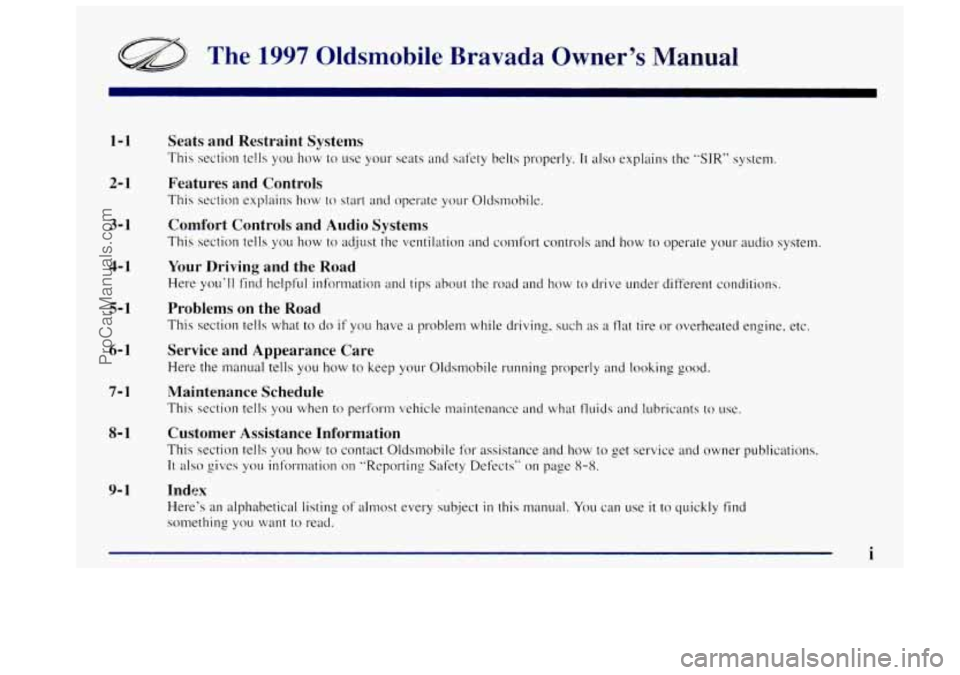
The 1997 Oldsmobile Bravada Owner’s Manual
1-1
2- 1
3-1
4- 1
5- 1
6- 1
7-1
8- 1
9- 1
Seats and Restraint Systems
This section tells you how to use your seats and safety belts properly. It also explains the “SIR” system.
Features and Controls
This section explains how to start and operate your Oldsmobile.
Comfort Controls and Audio Systems
This section tells you how to ad-just the ventilation and comfort controls and how to operate your audio system.
Your Driving and the Road
Here you’ll find helpful information and tips about the road and how to drive under different conditions.
Problems on the Road
This section tells what to do if you have a problem while driving, such as a flat tire or overheated engine. etc.
Service and Appearance Care
Here the manual tells you how to keep your Oldsmobile running properly and looking good.
Maintenance Schedule
This section tells you when to perform vehicle maintenance and what fluids and lubricants to use.
Customer Assistance Information
This section tells you how to contact Oldsmobile for assistance and how to get service and owner publications.
It also gives you information on “Reporting Safety Defects” on page 8-8.
Index
Here‘s an alphabetical listing of almost every subject in this manual. You can use it to quickly find
something you want
to read.
i
ProCarManuals.com
Page 148 of 358
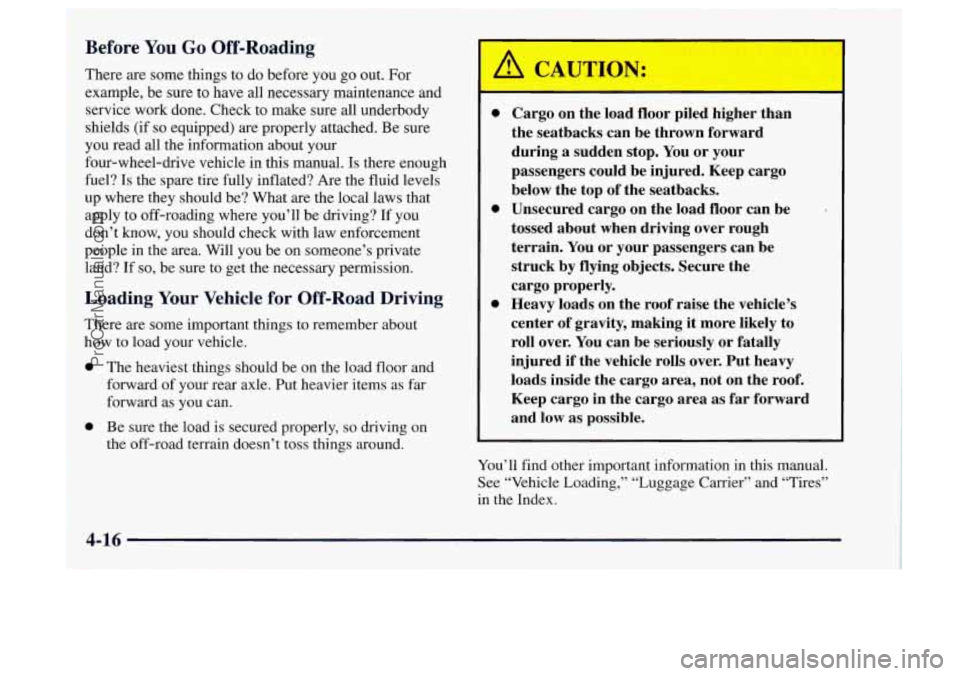
Before You Go Off-Roading
There are some things to do before you go out. For
example, be sure to have all necessary maintenance and
service work done. Check to make sure all underbody
shields (if
so equipped) are properly attached. Be sure
you read all the information about your
four-wheel-drive vehicle in this manual.
Is there enough
fuel?
Is the spare tire fully inflated? Are the fluid levels
up where they should be? What are the local laws that
apply to off-roading where you’ll be driving? If you
don’t know, you should check with law enforcement
people in the area. Will you be on someone’s private
land? If
so, be sure to get the necessary permission.
Loading Your Vehicle for Off-Road Driving
There are some important things to remember about
how to load your vehicle.
0 The heaviest things should be on the load floor and
forward of your rear axle. Put heavier items as far
forward as you can.
0 Be sure the load is secured properly, so driving on
the off-road terrain doesn’t toss things around.
0 Cargo on the load floor piled higher than
the seatbacks can be thrown forward
during
a sudden stop. You or your
passengers could be injured. Keep cargo
below the top of the seatbacks.
0 Unsecured cargo on the load floor can be
tossed about when driving over rough
terrain. You or your passengers can be
struck by flying objects. Secure the
cargo properly.
0 Heavy loads on the roof raise the vehicle’s
center of gravity, making
it more likely to
roll over. You can be seriously or fatally
injured if the vehicle rolls over. Put heavy
loads inside the cargo area, not on the roof.
Keep cargo in the cargo area
as far forward
and low
as possible.
You’ll find other important information in this manual.
See “Vehicle Loading,” “Luggage Carrier” and “Tires’’
in the Index.
ProCarManuals.com
Page 167 of 358

Once you are moving on the freeway, make certain you
allow a reasonable following distance. Expect to move
slightly slower at night.
When you want to leave the freeway, nwve to the proper
lane well
in advance. If you miss your exit, do not,
under any circumstances, stop and back up. Drive on to
the next exit.
The exit ramp can be curved, sometimes quite sharply.
The exit speed is usually posted.
Reduce your speed according to your speedometer, not
to your sense
of motion. After driving for any distance
at higher speeds, you may tend to
think you are going
slower than you actually are.
Before Leaving on a Long Trip
Make sure you're ready. Try to be well rested. lf you
must start when you're not fresh
-- such as after a day's
work
-- don't plan to make too many miles that first part
of the journey. Wear comfortable clothing and shoes you
can easily drive
in.
Is your vehicle ready for a long trip'! If you keep it
serviced and maintained, it's ready to go. If it needs
service, have
it done before starting out. Of course,
you'll find experienced and able service experts
in
Oldsmobile retailers all across North America. They'll
be ready and
willing to help if you need it.
Here are some things you can check before a trip:
0
0
0
0
0
0
0
Wildshield Wnsher Fluid: Is the reservoir full'? Are
all windows clean inside and outside'?
Wiper
Blades: Are they in good shape'?
Frwl, EIlgirw Oil, Other Fluids: Have YOU checked
all levels'?
Lcrnzps: 4re they all working? Are the lenses clean'?
Tires: They are vitally important to
a safe,
trouble-free trip.
Is the tread good enough for
long-distance driving? Are the tires
a11 inflated to the
recommended pressure?
Welrther
Forcmsts: What's the weather outlook
along your route? Should you delay your trip a short
time to avoid
a major storm system'?
A4ups: Do you have up-to-date maps'?
4-35
ProCarManuals.com
Page 168 of 358

Highway Hypnosis
Is there actually such a condition as “highway hypnosis”‘?
Or is
it just plain falling asleep at the wheel? Call it
highway hypnosis, lack of awareness, or whatever.
There is something about an easy stretch of road with
the same scenery, along with the
hum of the tires on the
road, the drone
of the engine, and the rush of the wind
against the vehicle that can make you sleepy. Don’t let it
happen to you!
If it does, your vehicle can leave the
road
in less than a second, and you could crash and
be injured.
What can you do about highway hypnosis? Erst, be
aware that
it can happen.
Then here are some tips:
0 Make sure your vehicle is well ventilated, with a
comfortably cool interior.
0 Keep your eyes moving. Scan the road ahead and
to the sides. Check your mirrors and your
instruments frequently.
If you get sleepy, pull off the road into a rest, service
or parking area and take a nap, get some exercise, or
both. For safety, treat drowsiness on the highway
as
an emergency.
Hill and Mountain Roads
Driving on steep hills or mountains is different from
driving
in flat or rolling terrain.
4-36
ProCarManuals.com
Page 174 of 358
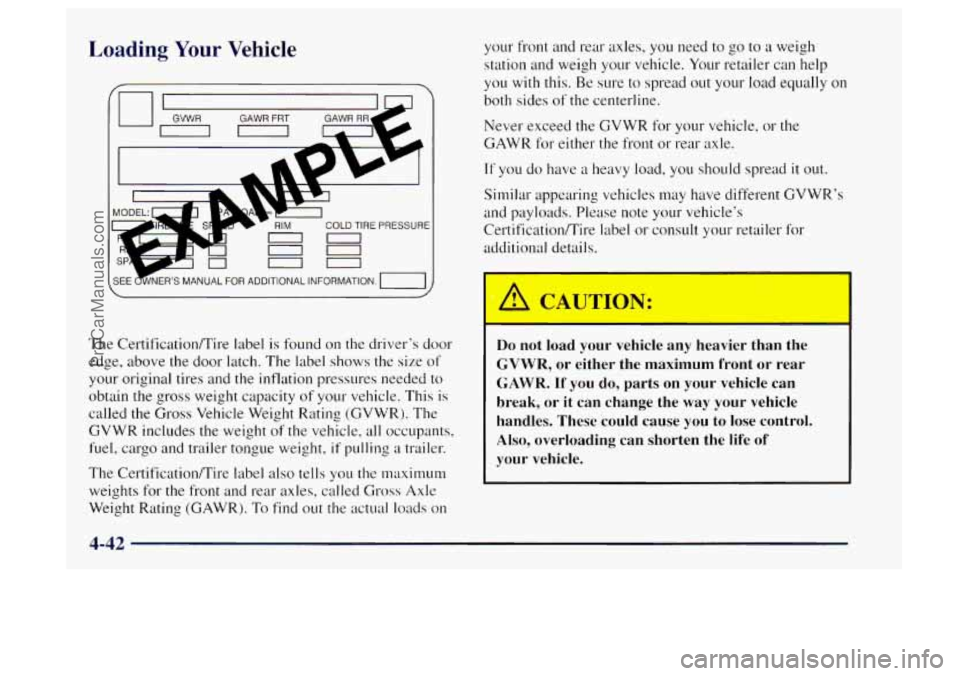
Loading Your Vehicle
The Certification/Tire label is found on the driver’s door
edge, above the door latch. The label shows the size of
your original tires and the inflation pressures needed to
obtain the gross weight capacity
of your vehicle. This is
called the
Gross Vehicle Weight Rating (GVWR). The
GVWR includes the weight
of the vehicle, all occupants,
fuel, cargo and trailer tongue weight,
if pulling a trailer.
The Certification/Tire label also tells you the maximum
weights
for the front and rear axles, called Gross Axle
Weight Rating (GAWR).
To find out the actual loads on your
front and rear axles, you need to
go to a weigh
station and weigh your vehicle.
Your retailer can help
you
with this. Be sure to spread out your load equally on
both sides
of the centerline.
Never exceed the GVWR for your vehicle,
or the
GAWR for either the front
or rear axle.
If you do have a heavy load, you should spread it out.
Similar appearing vehicles may have different GVWR’s
and payloads. Please note
your vehicle’s
Certificationflire label or consult your retailer
for
additional details.
Do not load your vehicle any heavier than the
GVWR, or either the maximum front or rear
GAWR. If you do, parts on your vehicle can
break, or it can change the
way your vehicle
handles. These could cause you to lose control.
Also, overloading can shorten the life of
your vehicle.
4-42
ProCarManuals.com
Page 179 of 358
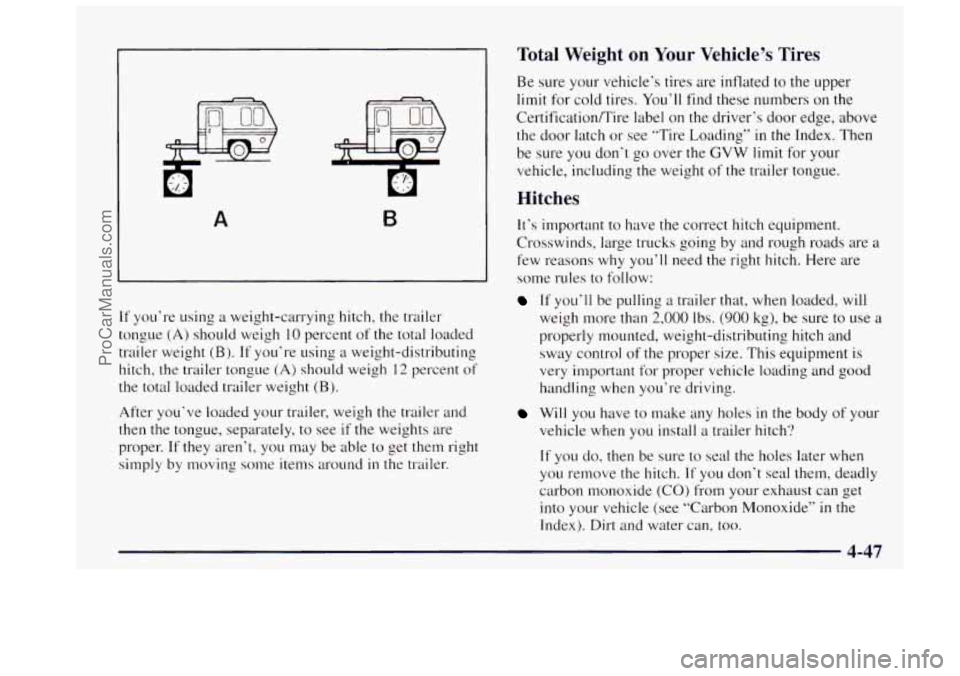
A B
If you’re using a weight-carrying hitch, the trailer
tongue
(A) should weigh 10 percent of the total loaded
trailer weight
(B). If you’re using a weight-distributing
hitch, the trailer tongue
(A) should weigh 12 percent of
the total loaded trailer weight
(B).
After you’ve loaded your trailer, weigh the trailer and
then the tongue, separately, to see
if the weights are
proper.
If they aren’t, you may be able to get them right
simply by moving some items around
in the trailer.
Total Weight on Your Vehicle’s Tires
Be sure your vehicle’s tires are inflated to the upper
limit
for cold tires. You’ll find these numbers on the
Certification/Tire label
on the driver’s door edge, above
the door latch or see “Tire Loading”
in the Index. Then
be sure
you don’t go over the GVW limit for your
vehicle, including the weight
of the trailer tongue.
Hitches
It’s important to have the correct hitch equipment.
Crosswinds, large trucks going by and rough roads are
a
few reasons why you’ll need the right hitch. Here are
some rules
to follow:
If you’ll be pulling a trailer that, when loaded, will
weigh more than 2,000 Ibs. (900 kg), be sure to use a
properly mounted, weight-distributing hitch and
sway control of the proper size. This equipment is
very important for proper vehicle loading and good
handling when you’re driving.
Will you have to make any holes in the body of your
vehicle when you install a trailer hitch?
If you do, then be sure to seal the holes later when
you relnove the hitch.
If you don’t seal them, deadly
carbon monoxide (CO) from your exhaust can get
into your vehicle (see “Carbon Monoxide”
in the
Index). Dirt and water can, too.
4-47
ProCarManuals.com
Page 187 of 358

Section 5 Problems on the Road
Here you’ll find what to do about some problems that can occur on the road.
5-2
5-3
5-3
5-7
5- 10
5-11
5-12
5- 12
5- 14 How
to Use
Warning Flashers
Other Types of Warning Devices
Step-by-step Procedure for Jump Starting
Information You Should Know Before Towing
Towing Your Vehicle From the Front
Towing Your Vehicle From the Rear
If Your Engine
is Overheating
If Steam is Coming From Your Engine
Cooling System 5-16
5-21
5-21
5-29
5-30
5-3 1
5-32
5-32 How to Add
Coolant
What to do if a Tire Goes Flat
How to Change a Flat Tire
Where to Store the Flat Tire and Tools
Information on the Compact Spare Tire
If You’re Stuck in Sand, Mud, Snow or on Ice
How to Rock Your Vehicle to Get Unstuck
Using Recovery Hooks
5-1
ProCarManuals.com
Page 207 of 358
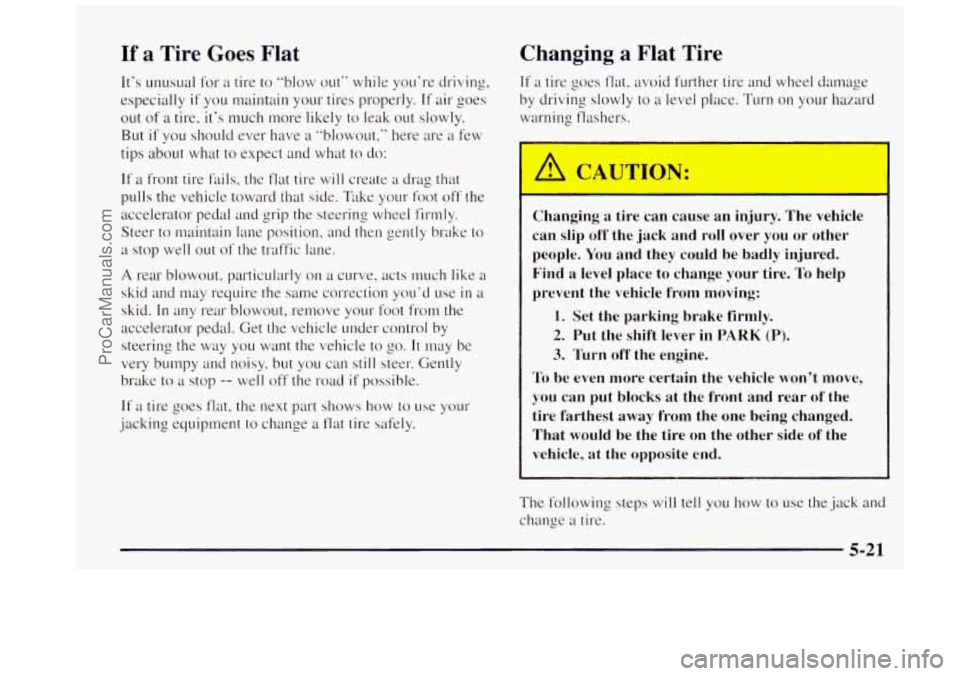
If a Tire Goes Flat
It’s Llnusual for a tire to ”blow out.’ while you’re driving,
especially
if you maintain your tires properly. If air goes
out of a tire, it’s much more likely to leak out slowly.
But
if you should ever have a “blowout,” here are a few
tips about what to expect and what to do:
If a front tire fails, the flat tire will create a drag that
pulls the vehicle toward that side. Take your
f-bot off the
accelerator pedal and grip the steering wheel
firmly.
Steer to maintain lane position, and then gently brake to
a stop well out of the traffic lane.
A rear blowout. particularly on a curve, acts much like a
skid and may require the same conxxtion you’d use in a
skid. In any rear blowout, remove your foot from the
accelerator pedal. Get the vehicle under control by
steering the way
you want the vehicle to go. It may be
very bumpy and noisy, but
YOLI can still steer. Gently
brake to
a stop -- well off the road if possible.
If a tire goes flat, the next part shows how to use your
jacking equipment to change a flat tire safely.
Changing a Flat Tire
If a tire goes flat, avoid further tire and wheel damage
by driving slowly to
a level place. Turn on your hazard
warning flashers.
c
A CAUTION:
Changing a tire can cause an injury. The vehicle
can slip off the jack and roll over you
or other
people. You and they could be badly injured.
Find a level place to change your tire.
To help
prevent the vehicle from moving:
1. Set the parking brake firmly.
2. Put the shift lever in PARK (P).
3. Turn off the engine.
To be even more certain the vehicle won’t move,
you can put blocks at the front and rear of the
tire farthest away from the one being changed.
That would be the tire on the other side of the
vehicle, at the opposite end.
The following steps
will tell you how to use the jack and
change
a tire.
5-21
ProCarManuals.com